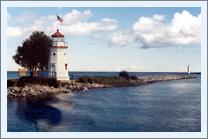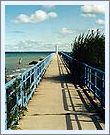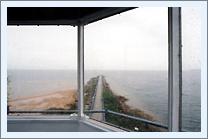 |
 |
 |
| Click on thumbnails to view enlarged versions | ||
| Cheboygan Crib Light | Seeing The Light |
|
|
|
|
Historical
Information The plan for the Cheboygan Crib Light as drawn-up by the District Engineer called for a round crib with an octagonal cast iron pierhead beacon centered upon it. While a contract for the fabrication and erection of the cast iron tower was awarded late in 1883, work on the crib itself did not begin until the opening of the 1884 season of navigation.
The district Lampist arrived at the site to install the flashing red Fourth Order Fresnel lens with a 159 candlepower kerosene-powered lamp. The occulting mechanism was carefully adjusted to ensure that the station's designated repeated 2 ½ second cycle was attained, consisting of a single ½ second flash followed by a 2 second eclipse. By virtue of the tower's location atop the eleven foot high crib, the lens sat at a focal plane of 36 feet, with a resulting range of visibility of ten miles under clear conditions.
There station was built without a dwelling in the crib, and since there was insufficient room within the tower for living space, it would appear that it was District Inspector Commander Francis A. Cook's plan to have the keeper live on shore. Since the Lighthouse Board annual reports of the time make specific mention of the fact that an Assistant Keeper was assigned to this station, it would appear likely that he operated under the supervision of the Keeper of the Cheboygan Range Lights, and thus likely lived in the Font Range dwelling with the Head Keeper. One can only imagine the drudgery involved for the keepers who manned this station. Every afternoon he would have to leave the safety of the dwelling in Cheboygan and row the ¼ mile out to the light in whatever weather the lake was dishing-up that day. On arrival at the crib, he would carefully secure his boat at the foot of the crib, and then gingerly step from the heaving boat onto the eleven foot ladder, climbing up to the deck while simultaneously carrying any supplies needed for the night. The lamp would illuminated at dusk, and the keeper would then sit in the solitude of the tower, huddled close to the stove to keep warm on cold nights during the late season, making frequent climbs to the lantern to adjust the light by trimming the wick, winding the occulting mechanism and adding fuel to the lamp. As dawn finally raised its head across the Straits of Mackinac, the lamp would be extinguished, and the illuminating apparatus, lens and lantern would be cleaned in preparation for illumination later that day. The keeper would then row the ¼ mile back to shore to get some sleep, knowing that he would have to back out on the crib to repeat the cycle a few short hours later.
In 1897, it would appear that the difficult conditions on the Crib came to the attention of the District Inspector, since it was in this year that a small dwelling and a pile protection for the boat were constructed on the crib. At the same time three and a half cords of riprap were placed around the base of the crib to protect against the action of the seas. The following year the District Lampist delivered a new and improved Fourth Order lamp to the station, increasing the distance of visibility to twelve miles. It is a particular property of wood that if it is either kept dry or wet at all times, it holds up for extremely long periods of time. However, wood that is subjected to alternating periods of wet and dry will begin to rot. With the crib and decking being constructed entirely of wood, it is not surprising that by 1899 the entire deck needed replacement, and an additional 28 cords of riprap were installed at the crib's base in an attempt to stave off the complete re-facing that was becoming clearly inevitable. To increase the effectiveness of the structure as a day mark, the main body of the tower received a coat of white paint in 1901, with the lantern room roof being painted a contrasting bright red.
To help preclude a reoccurrence of the 1906 collision, an automated fog bell was established on the crib in 1911, sounding a characteristic a single stroke every tens seconds.
It was likely during this time that the Crib Light became fondly known to locals as "The Dummy." A name that was commonly used when referring to the Light into the early 1980's, by which time crib had taken on a noticeable "leaning tower of Pisa" list, and was believed to be in danger of collapsing into the water. By this time, the use of Radio beacons, RADAR and LORAN-C had become universal in Great Lakes navigation, and the value of the Cheboygan Crib Light as an aid to navigation had decreased considerably. After evaluating the condition of the structure, the Coast Guard determined that the cost of stabilization and restoration would outweigh any navigational benefit, and made the difficult decision to scrap the iron tower and dynamite the crib into oblivion. Hearing of "the Dummy's" impending destruction, a number of Cheboygan citizens raised their voices to see if some arrangement could be made to save the century old landmark. An agreement was reached with the Coast Guard whereby the tower would be donated to the City of Cheboygan for display as a historical attraction, and a new home for the structure was identified on the West Breakwall off Gordon Turner Park. A contract was entered into with Ryba Marine of Cheboygan to relocate the tower and remove the crib.
When Dick Moehl and Sandy Planisek of the Great Lakes Lighthouse Keepers Association visited Cheboygan early in 2001, they were dismayed to find that the tower had deteriorated, with the Lexan having crazed, and the station leaking as a result of the caulking having fallen out over the years. They approaching the City with the proposal that they would offer their labor to restore the structure if the City would cover the cost of materials. Receiving approval for the project from the city, Dick and Sandy set to work on August 2, 2001. After re-caulking all joints throughout the structure and replacing the Lexan windows, they painted the tower in its historically accurate white paint, gray gallery and red roof and ventilator. Thanks to Dick and Sandy, the structure
now has a fighting chance of making into its fourth century! |